This article needs additional citations for verification .(September 2014) |
First family is an unofficial title for the family of a republic's head of state. A first family usually consists of: the head of state, the first spouse and their children.
This article needs additional citations for verification .(September 2014) |
First family is an unofficial title for the family of a republic's head of state. A first family usually consists of: the head of state, the first spouse and their children.
The term second family is often used to refer to the deputy head of state, usually a vice-president, or, in some countries, the family of the prime minister, in deference to a first family or royal family.[ citation needed ] The spouse is called the second lady or second gentleman.
The use of the term "first family" to refer to the family of the President of the United States only came into widespread use during the Kennedy administration with the tremendous popularity of Vaughn Meader's 1962 comedy album, The First Family. [1]
The First Family is also a collection of Australopithecus afarensis fossils discovered at site "333" at Hadar in Ethiopia, near the location of another famous A. afarensis, Lucy. A. afarensis is believed to be the first habitual bipedal hominid and a direct ancestor of Homo sapiens . This species lived between 3.9 million to 2.9 million years ago.
Salvatore Maranzano was an Italian-American mobster from the town of Castellammare del Golfo, Sicily, and an early Cosa Nostra boss who led what later would become the Bonanno crime family in New York City. He instigated the Castellammarese War in 1930 to seize control of the American Mafia, winning the war after the murder of rival faction head Joe Masseria in April 1931. He then briefly became the Mafia's capo di tutti capi and formed the Five Families in New York City, but was murdered on September 10, 1931, on the orders of Charles "Lucky" Luciano, who established an arrangement in which families shared power to prevent future turf wars: The Commission.
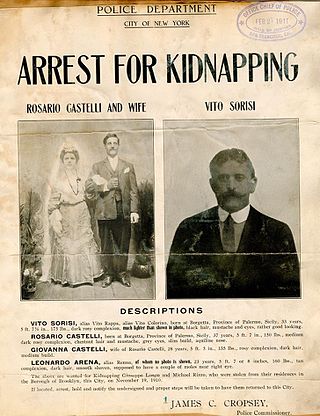
Black Hand was a type of Italian extortion racket. Originally developed in the eighteenth century, Black Hand extortion came to the United States in the later nineteenth century with immigrants.
The Castellammarese War was a bloody power struggle for control of the Italian-American Mafia that took place in New York City, New York, from February 1930 until April 15, 1931, between partisans of Joe "The Boss" Masseria and those of Salvatore Maranzano. The war was named after the Sicilian town of Castellammare del Golfo, the birthplace of Maranzano. Maranzano's faction won and divided New York's crime families into the Five Families; Maranzano declared himself capo di tutti i capi. However, Maranzano was murdered in September 1931 on orders of Lucky Luciano, who established a power-sharing arrangement called the Commission, a group of Mafia families of equal stature, to avoid such wars in the future.

William James Flynn was the director of the Bureau of Investigation from July 1, 1919, to August 21, 1921.
Nicolò Terranova, also known as Nicholas "Nick" Morello, was one of the first Italian-American organized crime figures in New York City he succeeded Giuseppe Morello as boss of the then Morello Gang in 1909 and was succeeded by Vincenzo Terranova in 1916. Along with his half-brother Giuseppe Morello and brothers Ciro and Vincenzo Terranova, he founded the Morello crime family, and was later one of the participants in the Mafia-Camorra War of 1915–17.

Giuseppe "the Clutch Hand" Morello, also known as "The Old Fox", was the first boss of the Morello crime family and later top adviser to Giuseppe "Joe the Boss" Masseria. He was known as Piddu and his rivals the Castellammarese knew him as Peter Morello. He was famous for having a one-fingered deformed right hand that resembled a claw.
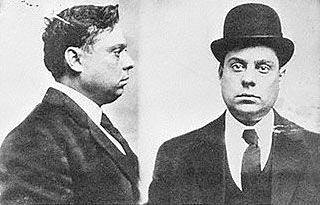
Ignazio Lupo, also known as Ignazio Saietta and Lupo the Wolf, was a Sicilian American Black Hand leader in New York City during the early 1900s. His business was centered in Little Italy, Manhattan, where he ran large extortion operations and committed other crimes including robberies, loan-sharking, and murder. By the start of the 20th century, Lupo merged his crew with others in the South Bronx and East Harlem to form the Morello crime family, which became the leading Mafia family in New York City.
Mike Dash is a Welsh writer, historian, and researcher. He has written books and articles about dramatic episodes in history.

Vito Cascio Ferro or Vito Cascioferro, also known as Don Vito, was a prominent member of the Sicilian Mafia. He also operated for several years in the United States. He is often depicted as the "boss of bosses", although such a position does not exist in the loose structure of Cosa Nostra in Sicily.

Ciro Terranova was an Italian-born New York City gangster and one time underboss of the Morello crime family.
Salvatore "Toto" D'Aquila was an early Italian-American Mafia boss in New York City of the D'Aquila crime family, what would later become known as the Gambino crime family.
Alfonso Sgroia, also known as "The Butcher" was a New York gang member who became a hitman for the Navy Street gang connected to the Camorra in New York City.
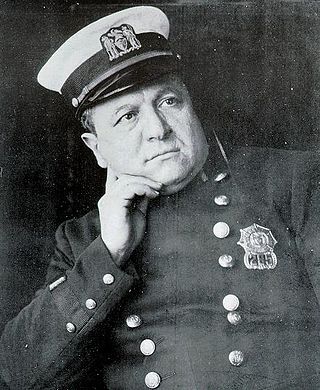
Joseph Petrosino was an Italian-born New York City Police Department (NYPD) officer who was a pioneer in the fight against organized crime. Crime fighting techniques that Petrosino pioneered are still practiced by law enforcement agencies.
Vincenzo "the Tiger of Harlem"Terranova was a gangster and an early Italian-American organized crime figure in the United States. He succeeded Nicholas Morello as boss of the then Morello Gang in 1916 and was succeed by Giuseppe Masseria in 1922. He served as boss and underboss of the Morello crime family, today known as the Genovese crime family, the oldest of the Five Families in New York City.
Pellegrino Morano (1877–unknown) was the head of a group of Neapolitans criminals with roots in the Camorra based in Coney Island, where he owned the Santa Lucia restaurant, which was often used as the headquarters for their gang, known as the Coney Island gang. He is also known as Marano.

Ralph "The Barber" Daniello (1886–1925) was a New York criminal who belonged to the Brooklyn Navy Street Gang and participated in a major gang slaying. Daniello eventually became an informant and helped destroy the Camorra crime gangs in Brooklyn.
The American Mafia, commonly referred to in North America as the Italian American Mafia, the Mafia, or the Mob, is a highly organized Italian American criminal society and organized crime group. The organization is often referred to by its members as Cosa Nostra and by the American government as La Cosa Nostra (LCN). The organization's name is derived from the original Mafia or Cosa nostra, the Sicilian Mafia, with "American Mafia" originally referring simply to Mafia groups from Sicily operating in the United States, as the organization initially emerged as an offshoot of the Sicilian Mafia formed by Italian immigrants in the United States. However, the organization gradually evolved into a separate entity partially independent of the original Mafia in Sicily, and it eventually encompassed or absorbed other Italian immigrant and Italian American gangsters and Italian American crime groups active in the United States and Canada that were not of Sicilian origin. In North America, it is often colloquially referred to as the Italian Mafia or Italian Mob, though these terms may also apply to the separate yet related Sicilian Mafia or other organized crime groups in Italy or ethnic Italian crime groups in other countries.
Barnet Baff was a poultry dealer in New York City who was murdered by organized crime that represented the "poultry trust" in New York that extorted $10 per truckload of poultry from merchants. His death led to an investigation of organized crime in New York City and led to the resignation of Captain John McClintock.
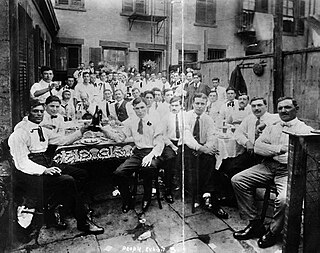
The Brooklyn Camorra or New York Camorra was a loose grouping of early-20th-century organized crime groups that formed among Italian immigrants originating in Naples and the surrounding Campania region living in Greater New York, particularly in Brooklyn. In the early 20th century, the criminal underworld of New York City consisted largely of Italian Harlem-based Sicilians and groups of Neapolitans from Brooklyn, sometimes referred to as the Brooklyn Camorra, as Neapolitan organized crime is referred to as the Camorra.
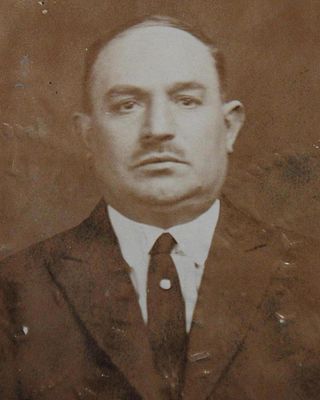
Nicolo "Cola" Schiro was an early Sicilian-born New York City mobster who, in 1912, became the boss of what later become known as the Bonanno crime family.